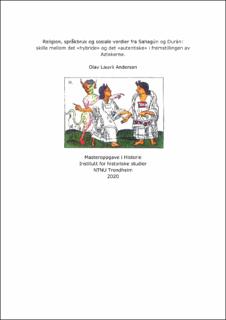| dc.contributor.advisor | Njåstad, Magne | |
| dc.contributor.advisor | | |
| dc.contributor.advisor | | |
| dc.contributor.advisor | Osei-Tutu, John Kwadwo | |
| dc.contributor.author | Andersen, Olav Lauvli | |
| dc.date.accessioned | 2021-09-13T16:05:49Z | |
| dc.date.available | 2021-09-13T16:05:49Z | |
| dc.date.issued | 2020 | |
| dc.identifier | no.ntnu:inspera:59158742:16567709 | |
| dc.identifier.uri | https://hdl.handle.net/11250/2775639 | |
| dc.description.abstract | Fagområde og problemstilling. Tema for oppgaven er Mexica-folkets kultur. Oppgaven besvarer følgende problemstilling: «Hvordan fremtrer det autentiske og det hybride i beskrivelser av Mexica hos Bernardino de Sahagún og Diego Durán?». Dette vil bli analysert gjennom temaene religion, sosiale verdier, rusmidler, skrift- og talespråk
Teorigrunnlaget og bakgrunn og hensikt med oppgaven. Historiene har sin bakgrunn fra spanjolenes erobringer og katolske munkers inntog i Mexico på begynnelsen av 1500 tallet. Hensikten er å se etter spor av det autentiske og hybride i tekster skrevet av katolske munker.
Metode. Som metode er det benyttet levninger i form av tekster
Data/kilder. De historiske verkene til forfatterne Bernardino de Sahagún og til Diego Durán; The Florentine Codex og History of the Indies of New Spain er kildene som blir benyttet.
Resultater/hovedkonklusjon
Presentasjonen av Mexica-folkets kultur er på flere områder preget av at forfatterne er katolske munker og har med sitt verdensbilde tolket det de har samlet av informasjon. Det autentiske kommer frem der det beskrives forhold som man med rimelighet sikkerhet kan anta enten ikke har blitt endret i det koloniale samfunnet, eller som i teksten ikke har blitt preget av forfatteren. Dette gjelder både innenfor gudeforståelsen, sosiale verdier og det språklige. Det hybride beskriver element fra kulturen som er påvirket av det kristen-europeisk verdenssynet Sahagún og Durán representerte og det er finnes en del av i tekstene. Dette kommer tydeligst frem i områder som omhandler myter, guder og kunst. | |
| dc.description.abstract | Abstract (English version)
Field of study/research question: The subject of this research paper is Spanish writing on the Aztec culture from 16th century. The thesis aims to answer the following research question: “How does the authentic and hybrid in descriptions of Mexica appear with Bernardino de Sahagún and Diego Durán?”. The topics of religion, values, drugs, written and oral language will be explored to analyze and answer the research question.
Purpose of thesis: The histories have their backgrounds from the Spanish inquisition and the Catholic monks’ entry to Mexico in the early 16th century. The aspiration/purpose is to look for trails of the authentic and hybrid in texts/scripts/scriptures written by Catholic monks.
Literature review: The historical works of Bernardino de Sahagún and Diego Durán, The Florentine Codex and History of the Indies of New Spain, are the primary sources for the thesis.
Methodology: Relics in the shape of texts.
Results/Conclusion:
The portrayal of the culture of the Aztecs has in several topics been marked by Catholic monks and how within their worldview, have interpreted from what they gathered. The authentic emerges when the description of Aztecs has been described which one can reasonably assume with certainty either have not been altered during the times of colonial society, or which in the text have not been influenced by the author. This applies both within the understanding of social activities, values and the field of linguistics. The hybrid describes elements from the culture that have influenced by the Christian-European worldview which both Sahagún and Durán represented and there are some of them in the texts. This is most evident in areas that deal with myths, gods and art. | |
| dc.language | | |
| dc.publisher | NTNU | |
| dc.title | Religion, språkbruk og sosiale verdier fra Sahagún og Durán: skille mellom det «hybride» og det «autentiske» i fremstillingen av Aztekerne. | |
| dc.type | Master thesis | |
